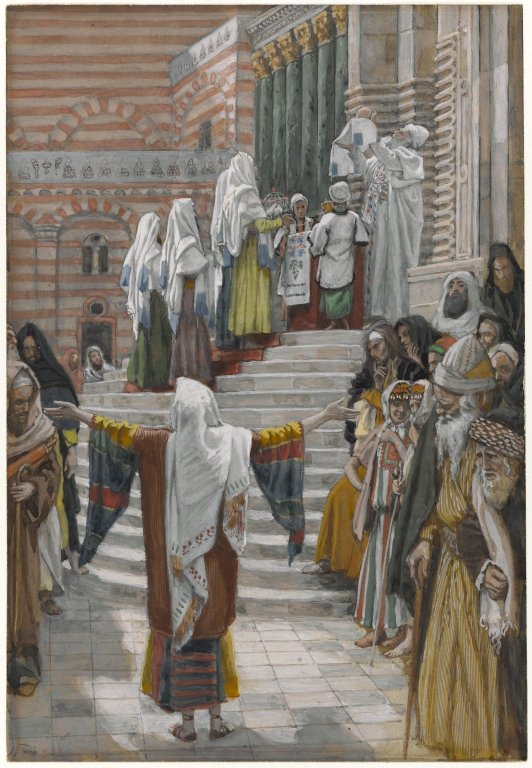“The presentation of Jesus in the temple shows him to be the firstborn Son who belongs to the Lord. With Simeon and Anna, all Israel awaits its encounter with the Savior … Jesus is recognized as the long-expected Messiah, the ‘light to the nations’ and the ‘glory of Israel,’ but also ‘a sign that is spoken against.’ The sword of sorrow predicted for Mary announces Christ’s perfect and unique oblation on the cross that will impart the salvation God had ‘prepared in the presence of all peoples’” (Catechism of the Catholic Church, 529).
The account of the Presentation (Luke 2:22 – 38) describes these spiritual overtones of Jesus’ initial experience at the great temple of Jerusalem. In so doing, it also portrays God’s all-encompassing love for His people of multiple ages and life stages: the Child Jesus, blossoming in His first weeks of infancy; the youthful Mary and Joseph, starting out together on the lifelong journey of parenthood; the elderly Simeon and Anna, seniority affording them precious time to focus on the inspirations of the Spirit.
Pausing along the way to ponder each section may facilitate meditating on this Gospel passage.
~ (22 – 24) “When the days were completed for their purification according to the law of Moses, they took him up to Jerusalem to present him to the Lord, just as it is written in the law of the Lord, ‘every male that opens the womb shall be consecrated to the Lord,’ and to offer the sacrifice of ‘a pair of turtledoves or two young pigeons,’ in accordance with the dictate in the law of the Lord.”
Mary and Joseph fulfill the requirements of the Law, including the offering of the poor for sacrifice. In their humility, they do not hold themselves above the Law but rather honor and obey it.
~ (25 – 32) “Now there was a man in Jerusalem whose name was Simeon. This man was righteous and devout, awaiting the consolation of Israel, and the Holy Spirit was upon him. It had been revealed to him by the Holy Spirit that he should not see death before he had seen the Messiah of the Lord. He came in the Spirit into the temple; and when the parents brought in the child Jesus to perform the custom of the Law in regard to him, he took him into his arms and blessed God, saying: ‘Now, Master, you may let your servant go in peace, according to your word, for my eyes have been your salvation, which you prepared in sight of all the peoples, a light for revelation to the Gentiles, and glory for your people Israel.’”
Bishop Robert Barron’s commentary characterizes Simeon as “a symbol of ancient Israel, watching and waiting for the coming of the Messiah … he embodied the expectation of the nation; and the Holy Spirit had given him the revelation that he would not die until he had laid eyes on his Savior.”
~ (33 – 35) “The child’s father and mother were amazed at what was said about him; and Simeon blessed them and said to Mary, his mother, ‘Behold, this child is destined for the fall and rise of many in Israel, and to be a sign that will be contradicted (and you yourself a sword will pierce) so that the thoughts of many hearts will be revealed.’”
Saint John Paul II explains: “Simeon’s words seem like a second Annunciation to Mary, for they tell her of the actual historical situation in which the Son is to accomplish his mission, namely, in misunderstanding and sorrow. While this announcement on the one hand confirms her faith in the accomplishment of the divine promises of salvation, on the other hand it also reveals to her that she will have to live her obedience of faith in suffering, at the side of the suffering Savior, and that her motherhood will be mysterious and sorrowful” (Redemptoris Mater).
~ (36 – 38) “There was also a prophetess, Anna, the daughter of Phanuel, of the tribe of Asher. She was advanced in years, having lived seven years with her husband after her marriage, and then as a widow until she was eighty-four. She never left the temple, but worshiped night and day with fasting and prayer. And coming forward at that very time, she gave thanks to God and spoke about the child to all who were awaiting the redemption of Jerusalem.”
Woman to woman, old to young, Anna surely felt deep compassion for Mary in light of Simeon’s ominous prophecy. Even so, she brought long years of prayer and fasting, and openness to the inspirations of the Holy Spirit, to fruition through a new ministry – that of evangelizing.
A quote from Pope Francis provides our conclusion: “The old receive from the young, while the young draw upon the old. The two young people … find themselves. And the two older people, nearing the end of their days, receive Jesus, the meaning of their lives … the young see their mission and the elderly realize their dreams. All because, at the center of the encounter, is Jesus” (Speech on this feast, 2018).
Keeping Jesus at the center of our lives – raising young children, working through midlife, or evangelizing in old age – remains both the message and the challenge of the Feast of the Presentation.
© All Rights Reserved, Living His Life Abundantly®/Women of Grace® http://www.womenofgrace.com










